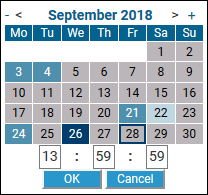Important Note
This space contains files and text snippets that are used throughout the Scheer PAS documentation.
This content is not meant to be read independently from the rest of the documentation.
- Created by Kirstin Seidel-Gebert, last modified on Oct 10, 2019
You are viewing an old version of this page. View the current version.
Compare with Current View Page History
« Previous Version 42 Next »
Oops, it seems that you need to place a table or a macro generating a table within the Table Filter macro.
The table is being loaded. Please wait for a bit ...
| Group | Name | Excerpt | ||||||||||||
|---|---|---|---|---|---|---|---|---|---|---|---|---|---|---|
| Action Language | deprecated_alias_macros | All macros that get information from aliases are deprecated since Builder 7.5.0. Please use the new Alias Reader instead. | ||||||||||||
| Adapter | correlation_ID | The xUML Runtime assigns a correlation ID to each adapter call. This ID is stored in header field X-Bridge-CorrelationID. Adapter calls can be identified by this ID. Also, it is logged to the transaction log. | ||||||||||||
| Logging | date_picker | When filtering the log entries of a service by date and time, you can use a date picker to select a date from/to. Click the date picker icon
The time part will be only visible if the related log entries contain a time part in format "HH:MM:SS". In all other cases, it is not possible to select log entries by time. Some dates within the calendar are colored to help you finding the appropriate date:
Select a day, enter a time (if necessary), and click OK to apply the selected date to the search field. | ||||||||||||
| Logging | date_search | Select the date/time range you want to inspect.
| ||||||||||||
| Logging | ls_date_filter_settings | Click View to update the displayed logging information. The date filter settings will be kept as long as your Browser tab is open. They will be reset to default as soon as you open the Logging tab in a new Browser tab. If you close your Browser with the Logging tab open, and start your Browser again with restoring all recent tabs (session restore), your date filter settings will be reloaded from your previous search. | ||||||||||||
| Logging | ls_search_for | Insert a string or a valid regular expression to search the log entries for. Only log entries that match the expression will be displayed. Pressing Enter in this field triggers the search. | ||||||||||||
| PState | pstate_owner | In Load Balancing context, when e.g. running multiple Bridges, you can setup persistent state services to share persistent state objects. The persistent state objects are distinguished by an owner and owner id reflecting the actual service that owns these objects. | ||||||||||||
| PState | pstate_service_transfer | Transfer the service to another Bridge (e.g. by service export and re-deployment). | ||||||||||||
| PState | pstate_warning_external_attributes | Do not switch an attribute between internal and external unless you are sure that no objects of the related class are still pending in the persistent state db. The attribute contents will get lost in this case. | ||||||||||||
| Service | get_pid | If the service is up and running, you can see the system process id (PID) of the service. To match the PID with the Bridge service, you can also use system commands:
| ||||||||||||
| Service | http_headers | Runtime 2019.9 Bridge services read the following HTTP headers containing correlation information:
These headers will be all logged to the transaction log. Having this information, you can use this for error analysis or usage metrics. | ||||||||||||
| Service | http_headers_adapter | Runtime 2019.9 xUML service adapters add the following HTTP headers containing correlation information to the request:
Transaction id and request id will be logged to the transaction log on the adapter call. Having this information, you can use this for error analysis or usage metrics. | ||||||||||||
| Service | kill_service | Bridge 7.2.0 The Kill functionality will first try to regularly stop the service. When the service is still running after 10 seconds, it will forcibly terminate the service with Java Process.destroyForcibly(). | ||||||||||||
| Service | stop_service | Bridge 7.2.0 Clicking Stop will send | ||||||||||||
| Service Preferences | automatic_restart | Whenever the service crashes, it will restart immediately. Nevertheless, in the navigation the icon | ||||||||||||
| Service Preferences | automatic_startup | Select this option, if you want the service to startup automatically, whenever the Bridge is started. Only users who are member of a group, to which the role ADMIN has been assigned, are allowed to change this option. This option can be globally disabled by the Disable Automatic Service Startup option on the node instance preferences. When updating the BRIDGE, all deployed services (xUML, Node.js, and Java services) will be kept. However, the automatic startup option will be ignored on the very first start-up after the update. | ||||||||||||
| Service Preferences | minimum_uptime | To allow the Bridge to distinct whether the service has crashed during start-up or not, specify the minimum uptime of the Node.js service in seconds. Implications:
| ||||||||||||
| Service Preferences | owner | The group id of the user who has deployed the service. Only users who are member of a group, to which the role ADMIN has been assigned, are allowed to modify the owner of the service. | ||||||||||||
| Update | service_startup_after_update | When updating the BRIDGE, all deployed services (xUML, Node.js, and Java services) will be kept. However, the automatic startup option will be ignored on the very first start-up after the update. |
- No labels
